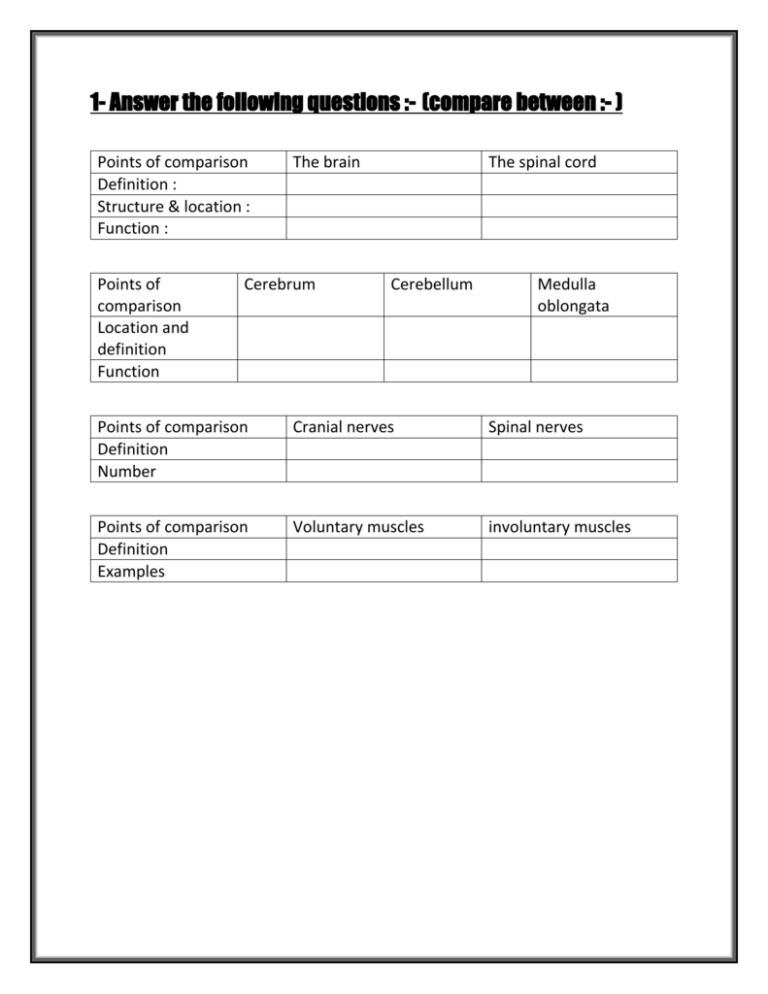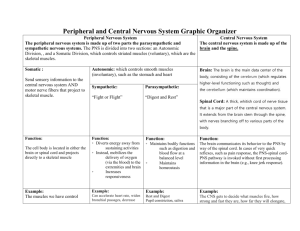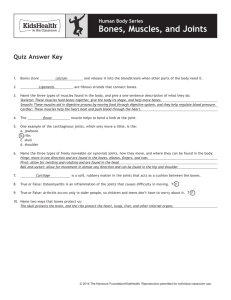revision 4
advertisement

1- Answer the following questions :- (compare between :- ) Points of comparison Definition : Structure & location : Function : Points of comparison Location and definition Function The brain Cerebrum The spinal cord Cerebellum Medulla oblongata Points of comparison Definition Number Cranial nerves Spinal nerves Points of comparison Definition Examples Voluntary muscles involuntary muscles 2-Complete the following chart:nervous system consists of : 1- 2- 1- 1- brain 2- 2- 2- 3- 1- 3-Locate each of the following parts in the human body:1- The brain 2- The two cerebral hemispheres 3- The spinal cord 4- The medulla oblongata 5- The cerebellum 6- Dendrites 7- The cerebral cortex 8- Axon terminals 4-What is the importance (function) of each of the following:1- Neuron 2- The brain 3- Spinal cord 4- The peripheral nervous system 5- The nervous system 6- Reflex action 7- The muscles 8- The joints 9- Tendons 10-Sternum (breast bone) 11- Upper limbs 12-lower limbs 13- Dendrites 14- The back bone 15 – Rib cage 5-What is meant by each of the following:1- Dendrites 2- The axon 3- Synapse 4- The gray matter 5- Peripheral nervous system 6- The nervous system 6-The following figure shows the arm in two different cases: a- Write the names of the bones and the muscles on the figure in the two different cases. b- Describe what happens to the muscles during each case. 7-Complete the following sentences:1- The human skeletal system consists of ……… and …………….. 2- The axial skeleton consists of ………, …………… and ……………. 3- The number of vertebrae of vertebral column is ………………. 4- The human ribcage consists of ………… pairs of ………………. 5- The ………….. Is the site of two bones meeting? 6- The first 10 pairs of ribs are connected to the …………. Bone 7- The joints is the location of meeting of ………….. 8- ………….. Are what fix muscles on bones? 9-lower limbs consists of …………., ………… and …………… 10 – Upper limbs consists of........... , ………….. And ………… 11- Knee and elbow joints are ……………… joints 12- The appendicular skeleton consists of ………. And ……….. 8-Give reasons for:1- Muscles play an important role in human movement 2- You must eat healthy food, rich in calcium, phosphorus and vitamin D 3- Rib cage surrounds both the heart and the lungs 5- The backbone contains cartilages between vertebrae 6- Damage of medulla oblongata causes death 7- It is important not to take pills without doctor’s prescription 9-Explain:Withdrawal of the hand quickly when it suddenly touches a hot surface 10-What will happen if:1-all the bones of the human body are without bones 2- Hip joints has a limited movement 3- The shoulder joints become from the limited movement joints 4- The front arm muscles relax and the back arm muscles contracts 11-Classify each of the following joints according to their types:1- Skull joints 2- Knee joint 3- Elbow joint 4- Shoulder joint 5-wrist joint 6- Thigh (hip) joint 12-Mention the ways to maintain your nervous system 13-Mention the ways to maintain your locomotors system 1- Answer the following questions :- (compare between :- ) Points of comparison Definition : Structure & location : Function : The brain It is a nerve block containing millions of nerve cells and it is the main control center in your body Inside ebony box called the skull The spinal cord It is a cylindrical cord from which the spinal nerves extend It extends in a channel within a series of vertebrae in the backbone It directs and coordinates It delivers the nerve all messages from the body processes,ideas,behaviours organs to the brain and and emotions vice versa - Responsible for reflex action Points of comparison Location and definition Function Cerebrum Cerebellum Medulla oblongata 1-It is divided into a right and a left halves which are called the cerebral hemispheres 2- Having many convolutions and folds on their surface. 1-Controlling the voluntary movements of the body such as running in races. 2-Receiving nerve impulses from sense organs (eyes, ears, nose, tongue and skin) and send appropriate responses to these impulses. 3- Contain the centers of thinking and memory. Cerebellum lies at the back area of the brain below two hemispheres. 1- in front of the cerebellum 2- It connects the brain with the spinal cord Maintaining the balance of the body during movement (regulating the involuntary movement such as) A-regulating heart beats. BRegulating the movement of the respiratory system parts during breathing. C- Regulating the movements and functions of the digestive system Points of comparison Definition Cranial nerves They are nerves that emerge from the brain Number 12 pairs Points of comparison Definition Voluntary muscles They are the muscles that can move willingly and you can control its movement. Examples 1- the limbs muscles 2- trunk muscles 3- face muscles 4- abdominal wall muscles Spinal nerves They are nerves that emerge from the spinal cord 31 pairs involuntary muscles They are the muscles that can move (automatically)and you can’t control or even aware of their movements 1- gastrointestinal tract 2- blood vessels 3- bladder muscles 2-Complete the following chart nervous system consists of : 2-peripheral nervous system 1- central nervous sysytem 1-cranial nerves 1- brain 2-cerebellum 2- spinal cord 1-cerebrum 3-medulla oblongata 2-spinal nerves 3-Locate each of the following parts in the human body:1- The brain Inside a bony box which called skull 2- The two cerebral hemispheres Inside the skull (the front part of the brain) 3- The spinal cord Extends in a channel within a series of vertebrae in the back bone 4- The medulla oblongata In front of cerebellum 5- The cerebellum At the back area of the brain below the two hemispheres 6- Dendrites Branches extends from the cell body 7- The cerebral cortex The outer surface of the two hemispheres 8- Axon terminals Nerve endings from the axon 4-What is the importance (function) of each of the following:1- Neuron The building unit of the nervous system (nerve cell) 2- The brain It is the main control center in your body. It directs and coordinates all the processes, ideas, behaviors and emotions 3- Spinal cord It delivers nerve messages from body organs to brain and vice versa. 2 It is responsible for the reflexes such as the withdrawal of the hand quickly on touching a hot surface. 4- The peripheral nervous system To get sensory information and kinetic responses between the central nervous system and all parts of the body 5- The nervous system 1-carry nerve messages from one of the areas of the body to another area. 2-It works on regulating and coordinating all the vital processes within the body. 3-It receives the external stimuli that surround the human being through the sensory organs and identifies and interprets them. 6- Reflex action When the body is subjected to an external stimuli such as light, heat, and smell, it makes an involuntary response by the nervous system. 7- The muscles. 1- Muscles generate mechanical energy and movement to the body. 2-Movement is generated by the ability of muscular cells to contract and relax. 8- The joints Allow the movement between the bones. 9- Tendons Long strips fix muscles to bones 10-Sternum (breast bone) Connect the first ten pairs of ribs interiorly 11- Upper limbs Eating, drinking, writing and holding things 12-lower limbs Walking, running, standing, sitting and carrying the rest of the body. 13- Dendrites Connected to neighboring neurons composing the synapse. 14- The back bone Allow the body to bend in different directions and protect the spinal cord inside. 15 – Rib cage To protect the lungs and the heart, in addition to helping in the inhalation and exhalation processes. 5-What is meant by each of the following:1- Dendrites branches extending from the neuron`s body 2- The axon It is a cylindrical axis covered with a fatty layer called myelin sheath 3- Synapse A composing from connected dendrites 4- The H gray matter The internal substances of the spinal cord. 5- Peripheral nervous system It is the nerves which emerge from the central nervous system; i.e. the brain and the spinal cord 6- The nervous system It is a communication and controlling device. It consists of the brain, the spinal cord and nerves. This important system receives information from your environment and from your body. Then, it interprets this information and makes the body respond to it. 6-The following figure shows the arm in two different cases A-front muscles – back muscles Hummers –fore arm- hand bones B-when the front muscles contract .the back muscles relax When the back muscles contract .the front muscles relax 7-Complete the following sentences:1- The human skeletal system consists of …axial skeleton…… and …appendicular skeleton………….. 2- The axial skeleton consists of …rib cage ……, ……backbone……… and ………skull……. 3- The number of vertebrae of vertebral column is ………33………. 4- The human ribcage consists of ……12…… pairs of ………ribs………. 5- The ……joint…….. Is the site of two bones meeting . 6- The first 10 pairs of ribs are connected to the ……breast……. Bone 7- The joints is the location of meeting of …two bones……….. 8- …tendons……….. Are what fix muscles on bones? 9-lower limbs consists of …femur………., ……shaft…… and ……foot bones……… 10 – Upper limbs consists of ....hummers......., ……forearm…….. And …hand bones……… 11- Knee and elbow joints are ……slightly movable (limited)………… joints 12- The appendicular skeleton consists of …lower limbs……. And …upper limbs…….. 8-Give reasons for:1- Muscles play an important role in human movement A- Muscles generate mechanical energy and movement to the body. B-Movement is generated by the ability of muscular cells to contract and relax. 2- You must eat healthy food, rich in calcium, phosphorus and vitamin D To prevent bone diseases such as steomalacia and rickets 3- Rib cage surrounds both the heart and the lungs to protect them 5- The backbone contains cartilages between vertebrae To prevent the friction between vertebrae 6- Damage of medulla oblongata causes death (Regulating the involuntary movement such as) A-regulating heart beats. B- Regulating the movement of the respiratory system parts during breathing. C- Regulating the movements and functions of the digestive system 7- It is important not to take pills without doctor’s prescription Because it make the nervous system exhausted 9-Explain:Withdrawal of the hand quickly when it suddenly touches a thorn The severity of the thorns affects the nerve endings in the fingers resulting in nerve impulses. Nerve impulses are transmitted to the spinal cord through a sensory nerve fiber. Nerve impulses are transmitted from the spinal cord to arm muscles (without the brain’s intervention). Muscles contract and the arm withdraws away from the thorns. Other nerve impulses are transmitted from the spinal cord to the sensory centers in the brain which leads to the true sense of pain 10-What will happen if:1-all the bones of the human body are without bones Will not be able to move correctly 2- Hip joints has a limited movement we will not be able to walk correctly and our thigh will move in one direction 3- The shoulder joints become from the limited movement joints we will not be able move our arms correctly and our shoulder will move in one direction 11-Classify each of the following joints according to their types:1- Skull joints (immovable) 2- Knee joint (slightly movable joint) 3- Elbow joint (slightly movable joint) 4- Shoulder joint (freely movable joint) 5-wrist joint (freely movable joint) 6- Thigh (hip) joint(freely movable joint) 12-Mention the ways to maintain your nervous system: 1-Reducing the intake of the stimulating substances such as coffee and others as they affect sleeping periods and heart beats and lead to nervous tension as well. 2- Stay away from tranquilizers and stimulants. 3- Not exhausting the sensory organs by sitting for long periods in front of the computer and television. 4- Giving the body a sufficient period of rest especially during sleep. 5- Avoiding extreme exciting situations. 6- Staying away from sources of pollution because they passively affect the nervous system as noisy places and smoke emitted from exhausts of cars, factories 7- Doing physical exercises. 13-Mention the ways to maintain your locomotors system 1-Commitment on vaccinating children according to Ministry of Health’s instructions as well as giving children polio vaccinations at accurate times. 2- Eating healthy food rich in calcium, phosphorus and vitamin D to prevent bone diseases such as steomalacia and rickets. 3-Avoiding any behavior that leads to fractures and sprains such as jumping from high places and making violent movements. 4- Avoid carrying heavy things that exceed your ability to protect the skeleton, especially your backbone. 5-Sitting and standing correctly during studying or reading to avoid straining the neck or backbone vertebrae. 6-Exposing the body to sunlight for suitable periods due to its importance in providing the body with vitamin D. 7-exercising regularly.







